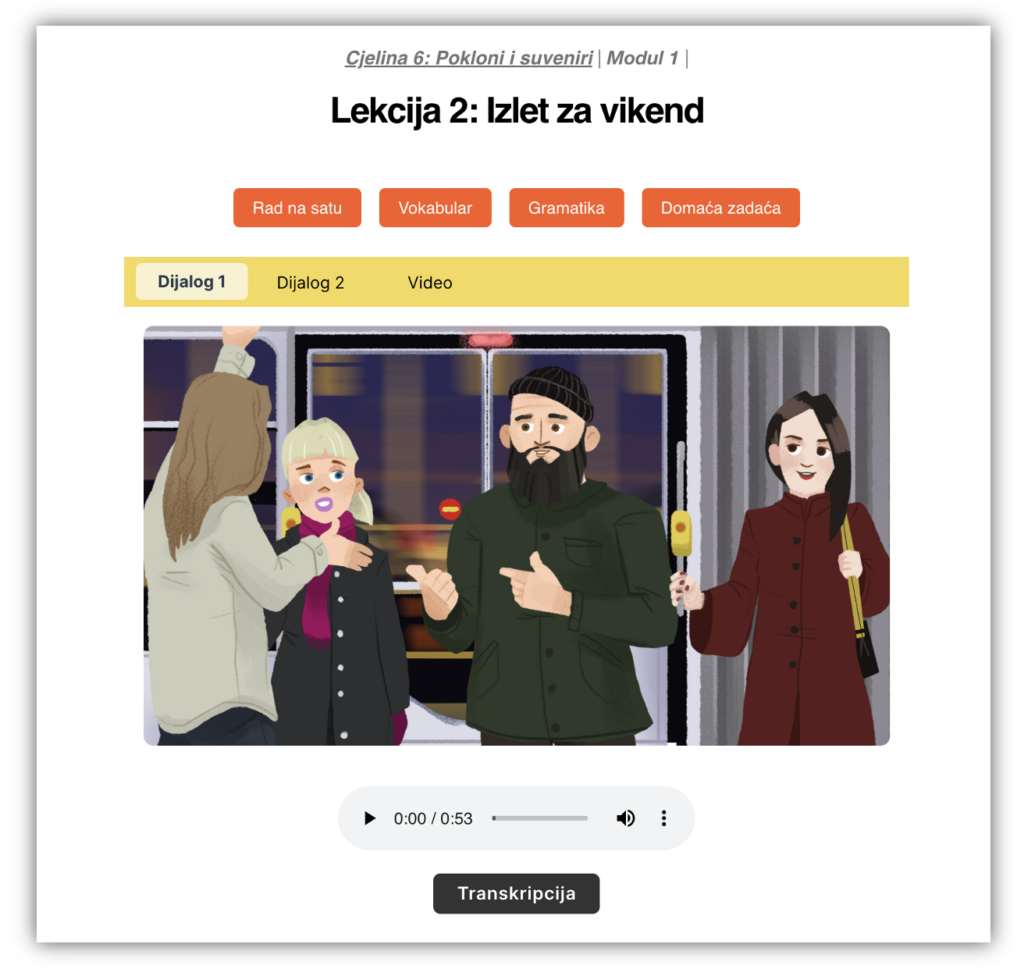Tako lako is a comprehensive curriculum designed for beginner university-level language learners who may not have the opportunity to engage with native or superior and advanced level speakers of Croatian outside of their formal instructional settings. However, those learning the language in Croatia will also greatly benefit from its content. For instance, its authentic simulations of real-life situations, which learners may encounter when using the language in the target-language environment, can furnish such learners with opportunities to gain a deeper understanding of the target culture.
Technological aspect
The Tako lako textbook can be easily accessed from desktop browsers such as Chrome, Firefox, and Safari, as well as on mobile devices or tablets using the Safari or Chrome browser. To ensure optimal performance, it is recommended to use Chrome.
Although it is feasible to use the textbook without signing into one’s Google account, it is strongly recommended for both learners and instructors to do so. This is due to the fact that signing in permits learners to download the materials and work on them directly, and allows instructors to customize the materials (if necessary) for their use.
Unit Structure
Each Unit in the textbook is divided into Modules, which are further divided into daily lessons. Units are organized around a topic, and the modules are organized as smaller parts of that larger topic. Here is an example from Unit 6 – Gifts and Souvenirs.
Module 1

Lesson 1: Plans and Wishes
Lesson 2: Weekend Trip
Module 2

Lesson 1: Thinking of Others
Lesson 2: You Are in My Thoughts
Module 3

Lesson 1: I Like it
Lesson 2: The Seventh Art
Lesson 3: Movie Night
Module 4

Lesson 1: (In) Appropriate Clothing
Lesson 2: Swiping the Credit Card
Module 5

Lesson 1: Review
Lesson 2: Conversation
Lesson Structure
Most lessons consists of Class materials, online Grammar practice, online Vocabulary practice, and Homework assignments.

Class Material
By dedicating a significant portion of class time to speaking tasks, the Tako lako curriculum recognizes the importance of actively practicing communication skills. This approach fosters learners’ confidence and fluency in spoken language. Speaking tasks in Tako lako aim to develop learners’ intercultural communicative competence and enable them to interact with L2 speakers on a variety of personal and social topics in everyday life. The speaking tasks are closely integrated with listening ones as they are highly interrelated in real-life situations (Sadiku, 2015). Listening activities are highly contextualized and accompanied by visual aids to help learners better understand the conversations. Since each lesson comprises a set of audio recordings of conversations that mimic real-life scenarios and sometimes video(s), listening becomes a routine task for learners.
Grammar
Together with explicit grammar explanations, the interactive assignments available in the Grammar (and Vocabulary) section are created using the HTML5 Package (H5P), which can be used in or outside of the classroom. The H5P tasks are particularly beneficial for independent learning, as they provide immediate feedback to learners. However, while these interactive tasks offer significant benefits in language learning, they may be treated as optional. Learners may disregard them entirely since they are not graded or submitted to the instructor. Even though these tasks are created using online tools, instructors have the option to integrate H5P tasks into their LMS course page and assign them as graded assignments. To do this, instructors need a basic understanding of how to download the H5P tasks from the website and incorporate them into their course page.
Vocabulary
While most textbooks typically provide a vocabulary list at the end of each unit, the Tako lako textbook presents the most important vocabulary for each lesson within its Vocabulary section. The key vocabulary is introduced within each lesson through visuals and reinforced through interactive tasks, enabling learners to actively engage in practicing new words and phrases. The vocabulary in Tako lako is drawn from everyday language, which learners are likely to encounter in their conversations on the given topic. This vocabulary is recycled throughout the textbook to ensure its acquisition over time.
Homework
A notable feature of the Tako lako textbook is its integration of a significant number of speaking activities into the homework assignments. Unlike traditional textbooks, many of which feature primarily written homework, the Tako lako textbook leverages the benefits of modern technology to foster student engagement outside of the classroom. These student-led homework assignments offer extensive speaking practice, allowing students to refine their conversational skills. Moreover, they serve as a valuable opportunity for the instructor to provide additional feedback to students on their developing speaking abilities.
Unit-Final Role-Play Task
The final lesson in each unit prepares learners to demonstrate their ability to navigate real-life situations in which they might find themselves in Croatia and display their intercultural communicative competence in a unit-final role-playing task. The value of this task lies not only in its ability to assess learners’ communication skills, but also in its potential to promote personal and social development. In demonstrating intercultural communicative competence learners showcase not only their interpersonal communication skills, as well as control of linguistic and sociolinguistic components, but also their ability to improvise, emotionally engage, and collectively negotiate meaning (Byram, 2020).

